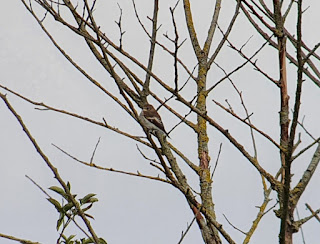Church Norton Trip Report, Guided Birdwatching 2nd August 2020
August is often a good month to see migrating waders, but on a guided outing to Church Norton early in the month it was the passerine migrants that stole the show.
The first small migrant seen was a scruffy blackcap feeding on berries, whilst on the ground a moulting green woodpecker pecked about. Rounding the corner we came across two reed warblers skulking in the bushes. Swallows were flying back and forth along the edge of the bushes lining the harbour, seemingly untroubled by our presence. At times they were flying within 2 metres of us. The reason for this activity materialised as a large gathering of young swallows were coating a cluster of branches. Seeing recently fledged birds such as these is a definite highlight of summertime.
Looking behind the hide numerous greenfinches jostled around as though they had itchy feet, linnets and goldfinches remained less angsty but nonetheless bouncy. Back to migrant spotting and several willow warblers and blackcaps were seen. Then something a bit different caught the eye; it was a handsome pied flycatcher. In spring and summer this is undoubtedly one of the most attractive of our small birds. They are somewhat more subdued in their autumn get up, but still remain high on the ‘desirability index’! Seconds after its identity was certain it decided to move through the bushes and threatened to be lost from view. Fortunately soon after this it sat out in the open again and we could admire it once more. This individual didn’t stay in one place for too long and went from bush to bush to fence and back again, it even spent some time on the ground. All the while we were afforded excellent views of this delightful bird.
 |
| Pied Flycatcher. Pictures taken with phone! |
With the tide rising it was time to look at what was in the harbour. Many terns were around, the breeding season was mostly behind us but there were still good numbers of little, common, and sandwich terns. We admired as several little terns came and fished in the closest channel of water, these tiny acrobats can’t fail to put a smile on your face. Waders were spread around the harbour, but no large flocks were seen. The most numerous species of wader was redshank but we also saw whimbrel, curlew, ringed plover, dunlin, oystercatcher and turnstones.
Returning our attention to the migrants in the bushes, whitethroats and blackcaps could be seen fattening up on the blackberries. After observing a few common whitethroats a lesser whitethroat appeared displaying its topical facial mask. It’s always a treat to see a lesser whitethroat, as they often remain hidden deep within their shrubby lairs.
A brownish warbler (‘aren’t they all’ I hear some say!) that could be seen for all of one tenth of a second was worthy of attention but alas it disappeared into the bushes. Patience was rewarded however when it reappeared and turned out to be a garden warbler. This is to my mind a rather attractive species. However, it certainly wins the award for most nondescript bird in Britain, in fact a lack of obvious features is perhaps this birds defining feature. It could be said that this plainness indicates that, aesthetically at least, everything is in perfect proportion and balance. Akin to the lesser whitethroats it was great to see this individual for such a prolonged period, as they tend to hide away. This took our warbler tally to six species.
 |
| Garden Warbler. |
Above the treetops numerous swallows and sand martins whizzed about. An increase in their level of chattering sounded the alarm at the arrival of a sparrowhawk. The hawk slowly drifted and circled over our heads, its underside illuminated excellently in the sun.
After putting the news of the pied flycatcher out many birders had arrived, some informed us that there were wheatears along a section in the harbour. We made a final stroll to see these and found one or two of them along the ridge of shingle. Heading back towards the car park and some movement once again caught the eye. It was the same blackcap, in the same place, that started us off earlier. A nice way to conclude the morning.
If you are interested in attending a guided birdwatching session such as this one, the upcoming events can be seen on the ‘Events’ page of this website. Or to stand the best chance of a space being available, you can get the information emailed to you prior to its publication online by joining my mailing list. To do so simply email me at baggaleyhugh@gmail.com
- Hugh Baggaley




Comments
Post a Comment